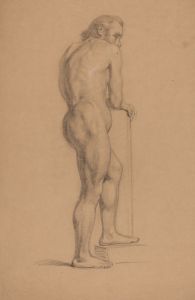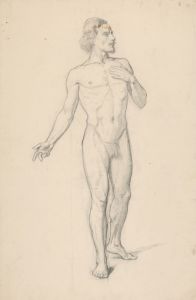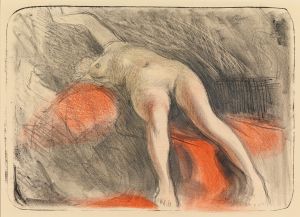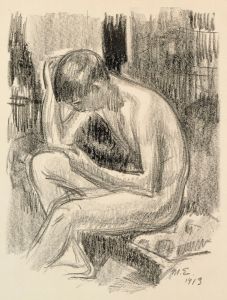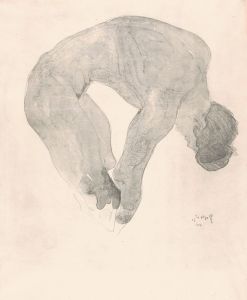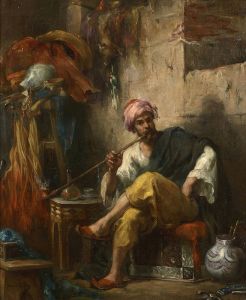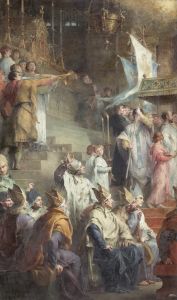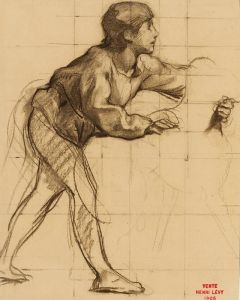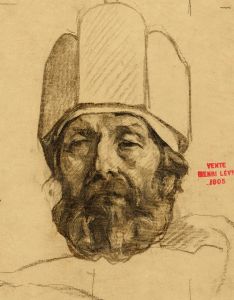
Etude d’une femme nue assise
A hand-painted replica of Henri Leopold Lévy’s masterpiece Etude d’une femme nue assise, meticulously crafted by professional artists to capture the true essence of the original. Each piece is created with museum-quality canvas and rare mineral pigments, carefully painted by experienced artists with delicate brushstrokes and rich, layered colors to perfectly recreate the texture of the original artwork. Unlike machine-printed reproductions, this hand-painted version brings the painting to life, infused with the artist’s emotions and skill in every stroke. Whether for personal collection or home decoration, it instantly elevates the artistic atmosphere of any space.
Henri Léopold Lévy was a French painter known for his works in the academic style, often focusing on historical and mythological subjects. One of his notable works is "Etude d’une femme nue assise," which translates to "Study of a Seated Nude Woman." This painting exemplifies Lévy's skill in capturing the human form with precision and sensitivity, a hallmark of his artistic approach.
Lévy was born on September 23, 1840, in Nancy, France. He studied at the École des Beaux-Arts in Paris, where he was a pupil of François-Édouard Picot and Alexandre Cabanel, both prominent figures in the academic art movement. Lévy's education under these masters deeply influenced his style, which is characterized by meticulous attention to detail and a strong emphasis on classical techniques.
"Etude d’une femme nue assise" reflects Lévy's commitment to the academic tradition, focusing on the anatomical accuracy and the play of light and shadow on the human body. The painting depicts a nude woman seated in a relaxed pose, her body turned slightly to the side. The composition highlights the contours and musculature of the figure, demonstrating Lévy's understanding of human anatomy and his ability to render it with lifelike realism.
The use of light in the painting is particularly noteworthy. Lévy employs chiaroscuro, a technique that contrasts light and dark to create a sense of volume and depth. This approach not only enhances the three-dimensionality of the figure but also adds a dramatic quality to the composition. The soft, diffused lighting gently illuminates the woman's skin, creating a warm and inviting atmosphere that draws the viewer's attention to the subject's serene expression and graceful posture.
Lévy's choice of subject matter—a nude study—aligns with the academic tradition of exploring the human form as a central theme in art. During the 19th century, such studies were considered essential for artists, serving as exercises in mastering the depiction of anatomy and movement. "Etude d’une femme nue assise" can be seen as part of this tradition, showcasing Lévy's technical prowess and his dedication to the ideals of academic art.
Throughout his career, Lévy exhibited his works at the Paris Salon, the official art exhibition of the Académie des Beaux-Arts, where he gained recognition for his historical and allegorical paintings. His contributions to the art world were acknowledged with several awards, including the prestigious Legion of Honor in 1875.
While "Etude d’une femme nue assise" may not be as widely known as some of Lévy's larger historical compositions, it remains an important example of his ability to capture the beauty and complexity of the human form. The painting serves as a testament to Lévy's skill as an artist and his commitment to the principles of academic art, which emphasized technical excellence and adherence to classical ideals.
In summary, Henri Léopold Lévy's "Etude d’une femme nue assise" is a masterful study of the human form, reflecting the artist's academic training and his dedication to the classical tradition. Through its careful composition and use of light, the painting exemplifies Lévy's ability to convey both the physical and emotional presence of his subject, making it a significant work in his oeuvre.





